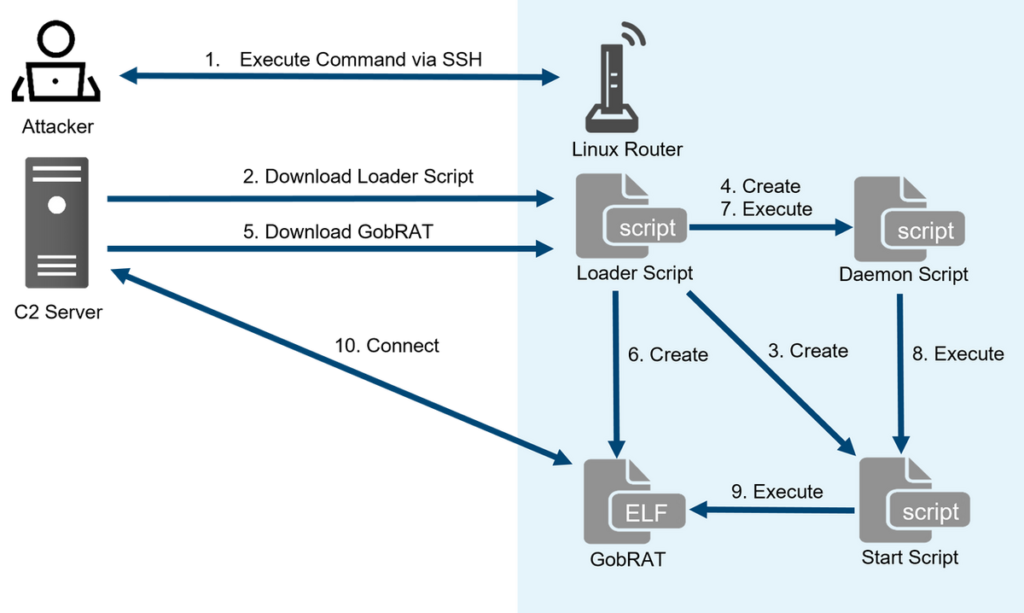GobRAT malware written in Go language targeting Linux routers

JPCERT/CC has confirmed attacks that infected routers in Japan with malware around February 2023. This blog article explains the details of the attack confirmed by JPCERT/CC and GobRAT malware, which was used in the attack.
Attack flow up to malware execution
Initially, the attacker targets a router whose WEBUI is open to the public, executes scripts possibly by using vulnerabilities, and finally infects the GobRAT. Figure 1 shows the flow of the attack until GobRAT infects the router.
Loader Script works as a loader, containing functions such as generating various scripts and downloading GobRAT. The SSH public key, which is assumed to be used for the backdoor, is hard-coded in the script. In addition, since Loader Script uses crontab to register the file path of Start Script for persistence, GobRAT does not have such function. The functions of Loader Script are as follows:
Disable Firewall function
Download GobRAT for the target machine’s architecture
Create Start Script and make it persistent
Create and run Daemon Script.
Register a SSH public key in /root/.ssh/authorized_keys
Figure 2 is the code of Start Script that executes GobRAT. The script is unique in that it writes the startup time to a file named restart.log. In addition, this script executes GobRAT under the file name apached to make it look like a legitimate process.
Figure 3 is the code of Daemon Script. This script checks whether Start Script is running or not every 20 seconds, and if not, it starts the script. This code has been possibly prepared in case Start Script is terminated unexpectedly.
GobRAT Overview
GobRAT is a RAT written in Go language and communicates with C2 server via TLS and executes various commands. It is packed with UPX version 4 series, and samples for various architectures such as ARM, MIPS, x86, and x86-64 have been confirmed. GobRAT performs the following checks at startup and keeps the information within the sample itself.
IP address and MAC address of itself
Uptime by uptime command
Network communication status by /proc/net/dev
The following sections describes the GobRAT’s communication method, encryption method, and commands to be executed.
Communication method
GobRAT uses TLS to send and receive data with its C2 server. Figure 4 shows an example of communication with the C2 server. The first 4 bytes indicate the size of the data, and the rest is gob[1] data. gob is a data serialization protocol available only in Go language. GobRAT uses gob for receiving commands and sending the results of command execution.
GobRAT defines gob data as a PACKAGE structure in the sample as follows.
type PACKAGE struct {
Type uint8 // CommandID
BotCount uint16 // Parameter
BotList []string // Command Parameter
ParamLength uint16 // Length of Param
Param map[string]string // Command Parameter
Content []uint8 // Command Parameter, Command Execution Result, etc
}
The fields used are different depending on the type of command, and string arrays, maps, and binary data are supported so that various types of parameters can be passed. In addition, while binary data can be stored in Content of the PACKAGE structure, map data with string is converted to binary data by encoding it with the json.Marshal function. The PACKAGE structure is used in various ways depending on the command, such as storing the data in Content, or converting the defined structure to binary data in the same way and storing it in Content.
Encryption Method
Strings such as C2 and Linux commands are encrypted and stored in the sample. Figure 5 shows the GobRAT’s decryption function. AES128 CTR mode is used to decrypt strings, and the key and IV are hard-coded in the sample. The same key (050CFE3706380723433807193E03FE2F) and IV (“12345678abcdefgh”) are used in all the confirmed samples. In addition, as shown in Figure 6, the codes that have probably been developed by the attacker, such as this decryption function, has a unique folder structure like aaa.com/bbb/me~.
Commands executed
GobRAT has 22 commands that are executed by the commands from the C2 server, and we have identified the following commands. Since the malware targets routers, you can see that most functions are related to communication, such as frpc, socks5, and reconfiguration of C2. See Appendix A for command details.
Obtain machine Information
Execute reverse shell
Read/write files
Configure new C2 and protocol
Start socks5
Execute file in /zone/frpc
Attempt to login to sshd, Telnet, Redis, MySQL, PostgreSQL services running on another machine
GobRAT Analysis Tools
Since GobRAT uses gob for communication, if you want to emulate its communication with C2 to check commands, you need to create a program using Go language. Our C2 emulation tool that supports GobRAT analysis is available on GitHub. Please download it from the following webpage for your analysis.
JPCERTCC/aa-tools/GobRAT-Analysis – GitHub
https://github.com/JPCERTCC/aa-tools-private/tree/master/GobRAT-Analysis
In Closing
In recent years, different types of malware using Go language have been confirmed, and the GobRAT malware confirmed this time uses gob, which can only be handled by Go language, for communication. Please continuously beware of malware that infects routers, not limited to GobRAT, since they are difficult to detect. Please refer to Appendix B for C2 of the malware, Appendix C for the hash value of the script, and Appendix D for the hash value of the malware.
Yuma Masubuchi
Translated by Takumi Nakano
Appendix A: Commands
Value
Contents
0x0
Update json data held in malware and acquire update results
0x1
Retrieve json data held in malware
0x3
Start reverse shell
0x4
End of reverse shell connection
0x6
Confirmation of reverse shell connection
0x7
Execute shell command for daemon
0x8
Execute shell command
0xD
Read/write specified file
0x10,0x11
Read/write specified file
0x16
Obtain various machine information such as df command
0x17
Set new communication channel for TCP
0x18
Execute SOCKS5 proxy with specified port and password
0x19
Execute SOCKS5 proxy on specified port
0x1a
New communication channel setting for UDP
0x1b
Execute frpc after executing SOCKS5 proxy on port 5555
0x1f
Check for the existence of the specified file
0x25
Login attempts for SSH, telenet, redis, mysql, postgres
0x27
Configuration of specified goroutine
0x2a
Scan to HTTP/HTTPS service of specified IP
0x2D
Dictionary attack to HTTP/HTTPS service of specified IP
0x30
C2 configuration related
0x31
DDoS attacks on SYN, TCP, UDP, HTTP, ICMP
Appendix B: C2
https[:]//su.vealcat[.]com
http[:]//su.vealcat[.]com:58888
https[:]//ktlvz.dnsfailover[.]net
http[:]//ktlvz.dnsfailover[.]net:58888
su.vealcat[.]com
ktlvz.dnsfailover[.]net
wpksi.mefound[.]com
Appendix C: Hash values of the scripts
060acb2a5df6560acab9989d6f019fb311d88d5511f3eda0effcbd9fc6bd12bb
feaef47defd8b4988e09c8b11967e20211b54e16e6df488780e2490d7c7fa02a
3e44c807a25a56f4068b5b8186eee5002eed6f26d665a8b791c472ad154585d1
60bcd645450e4c846238cf0e7226dc40c84c96eba99f6b2cffcd0ab4a391c8b3
Appendix D: Hash values of the malware
a8b914df166fd0c94106f004e8ca0ca80a36c6f2623f87a4e9afe7d86b5b2e3a
aeed77896de38802b85a19bfcb8f2a1d567538ddc1b045bcdb29cb9e05919b60
6748c22d76b8803e2deb3dad1e1fa7a8d8ff1e968eb340311fd82ea5d7277019
e133e05d6941ef1c2e3281f1abb837c3e152fdeaffefde84ffe25338fe02c56d
43dc911a2e396791dc5a0f8996ae77ac527add02118adf66ac5c56291269527e
af0292e4de92032ede613dc69373de7f5a182d9cbba1ed49f589ef484ad1ee3e
2c1566a2e03c63b67fbdd80b4a67535e9ed969ea3e3013f0ba503cfa58e287e3
98c05ae70e69e3585fc026e67b356421f0b3d6ab45b45e8cc5eb35f16fef130c
300a92a67940cfafeed1cf1c0af25f4869598ae58e615ecc559434111ab717cd
a363dea1efda1991d6c10cc637e3ab7d8e4af4bd2d3938036f03633a2cb20e88
0c280f0b7c16c0d299e306d2c97b0bff3015352d2b3299cf485de189782a4e25
f962b594a847f47473488a2b860094da45190738f2825d82afc308b2a250b5fb
4ceb27da700807be6aa3221022ef59ce6e9f1cda52838ae716746c1bbdee7c3d
3e1a03f1dd10c3e050b5f455f37e946c214762ed9516996418d34a246daed521
3bee59d74c24ef33351dc31ba697b99d41c8898685d143cd48bccdff707547c0
c71ff7514c8b7c448a8c1982308aaffed94f435a65c9fdc8f0249a13095f665e
References
[1] Gobs of data
https://go.dev/blog/gob
Article Link: GobRAT malware written in Go language targeting Linux routers – JPCERT/CC Eyes | JPCERT Coordination Center official Blog
1 post – 1 participant


